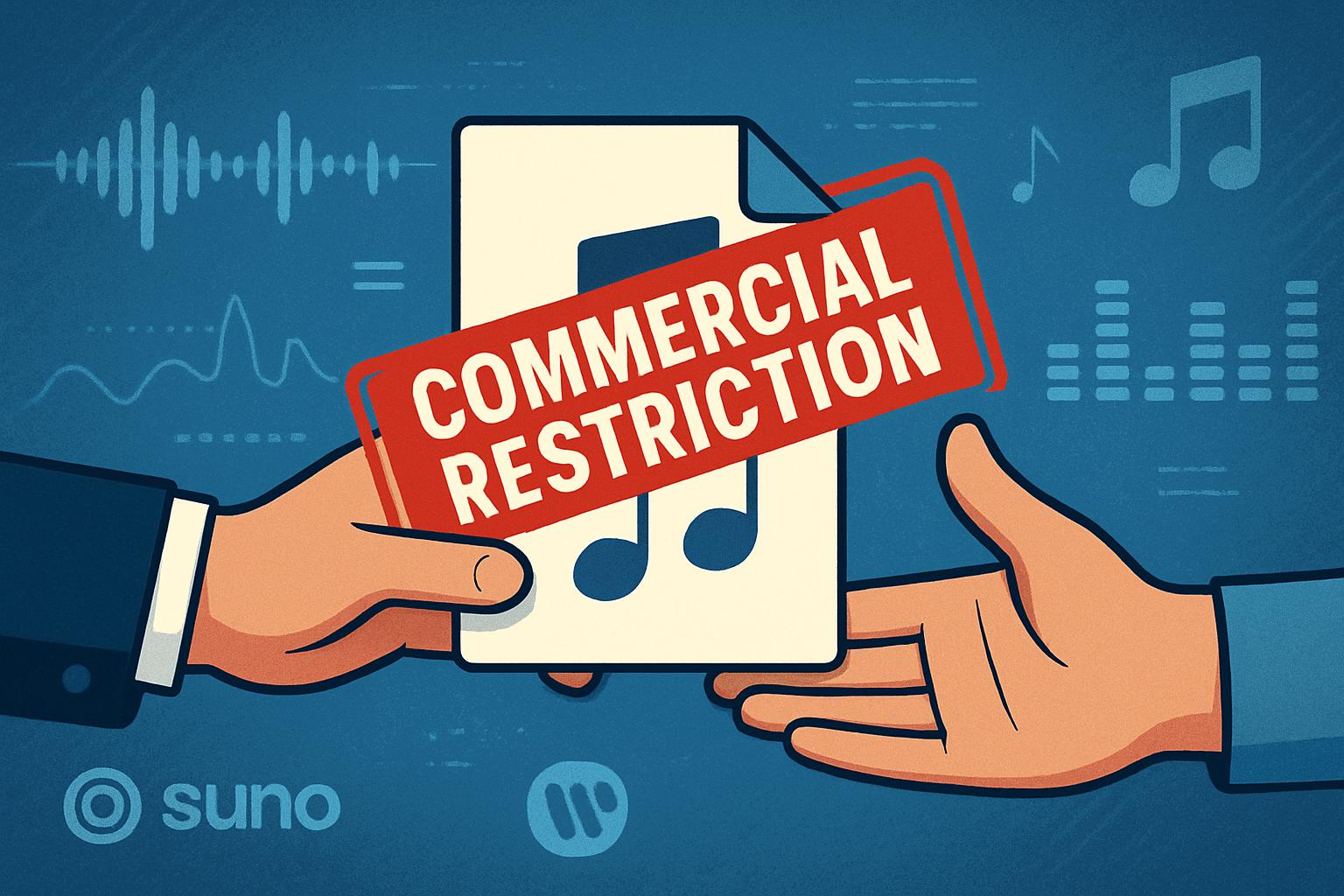
AI CERTS
1 day ago
Suno-WMG Deal Adds Commercial Restriction To AI Downloads
Industry leaders applaud the settlement, citing greater IP Protection and clearer revenue splits. However, community forums already bustle with worries about affordability, fairness, and creative freedom. Understanding the roadmap, therefore, becomes critical for labels, artists, and developers navigating rapid platform changes.

Commercial Restriction Deal Overview
The accord resolves WMG’s legal claims while authorizing Suno to train “licensed” models on opt-in catalogues. Additionally, Suno acquired Songkick, expanding its live-event footprint. Reuters notes Suno recently raised $250 million at a $2.45 billion valuation, underscoring investor confidence.
Robert Kyncl praised the pact, asserting that licensed AI finally rewards creators. Mikey Shulman echoed the sentiment, promising richer tools and artist collaborations. Nevertheless, several product unknowns linger, including exact pricing and royalty mechanics.
Key developments include:
- Licensed models launch in 2026, replacing current engines.
- Free users lose download rights yet keep streaming functions.
- Paid Tier subscribers receive monthly allowances with purchasable extras.
- Artists decide whether their likeness enters training data.
These milestones clarify immediate priorities. In contrast, unanswered questions around downstream rights leave creators wary. The following sections dissect implications section by section.
New Paid Access Model
Suno will gate file exports behind a redesigned Paid Tier. Furthermore, the company intends to introduce variable Download Caps per subscription level. Exact numbers remain unpublished, yet executives hint at flexible bundles for professionals.
For hobbyists, the change feels abrupt. Consequently, Reddit threads already showcase migration plans toward rival generators. Meanwhile, enterprise clients applaud the predictable cost structure, arguing that caps curb spam and maintain platform stability.
Pricing transparency will decide user loyalty. Therefore, Suno must reveal whether paid downloads include commercial licenses suitable for sync placements, streaming royalties, and merchandising. Without clarity, the new Commercial Restriction could stifle user growth instead of monetizing it.
A second variable involves carry-over. Existing subscribers ask if unused downloads roll into later months. Additionally, professionals seek confirmation that Suno Studio will preserve unlimited exports under distinct terms.
Ahead of launch, proactive communication would ease anxiety. However, the firm has only promised “details soon,” leaving speculation to flourish.
Artist Likeness Control Mechanisms
Under the partnership, WMG artists must opt in before their voices or images train Suno’s models. Moreover, creators retain veto power over individual tracks derived from their likenesses. This structure prioritizes IP Protection while supporting potential Monetization.
Revenue formulas stay hidden. Nevertheless, rights advocates view the framework as a blueprint for equitable AI exploitation. Consequently, competing labels are likely drafting similar clauses.
Artists will scrutinize reporting dashboards. Transparency around usage metrics, royalty splits, and algorithmic influence will determine adoption velocity. Without granular insights, skepticism could override enthusiasm.
These control levers empower talent. However, they introduce operational overhead for Suno, which must authenticate permissions at scale. Implementation success will shape broader industry trust.
Future Business Impact Forecasts
Analysts project that a metered download economy may accelerate recurring revenue. Additionally, married live-event data from Songkick could unlock hybrid offerings, boosting overall Monetization.
Yet the Commercial Restriction imposes friction that might deter casual users. In contrast, super-fans may accept caps if exclusive content or VIP interactions follow. Therefore, segmentation strategy will matter.
Suno claims to serve 100 million creators, but daily active counts are unverified. Consequently, actual conversion rates to the new Paid Tier remain speculative.
Professionals can enhance their expertise with the AI+ Cloud Specialist™ certification, preparing them to analyze evolving data pipelines supporting AI music services.
These forecasts emphasize revenue potential. However, operational swings could still upend projections if adoption lags.
Community Reaction And Concerns
Immediate creator commentary underscores tension between fairness and access. Many fear that download fees plus tight Download Caps limit experimentation. Additionally, doubts persist about derivative rights once tracks leave the platform.
Content strategists argue that a measurable Commercial Restriction can deter piracy. Nevertheless, indie musicians lament losing frictionless ownership of their own generative outputs.
Public relations missteps could magnify backlash. Therefore, Suno might launch educational webinars outlining legal benefits, cap flexibility, and upcoming features.
The community responses highlight adoption barriers. Consequently, platform updates must address perception gaps quickly.
Regulatory Landscape Policy Shifts
Lawmakers worldwide examine generative AI, copyright, and IP Protection. Moreover, WMG’s agreement illustrates a pivot from lawsuits to licensing, informing policy drafts in Europe and the United States.
UMG and Sony will watch performance indicators closely. Subsequently, similar deals could standardize Commercial Restriction clauses across major catalogues.
Regulators may demand public registries of licensed models. Additionally, auditing protocols could become mandatory, ensuring royalties reach rightful owners.
These policy vectors will pressure startups to adapt. However, early compliance may confer competitive advantages.
Next Steps For Stakeholders
Labels should negotiate transparent royalty dashboards and artist education programs. Meanwhile, creators must review forthcoming terms before committing assets.
Suno can mitigate churn through staged rollouts, flexible Download Caps, and bundled live-event perks. Furthermore, strategic collaborations with hardware manufacturers may sweeten Paid Tier value propositions.
Key stakeholder priorities include:
- Clarify download licensing scope and resale rights.
- Publish precise cap figures and overage costs.
- Define dispute resolution pathways for AI-generated content.
- Expand joint promotion opportunities leveraging concert data.
- Integrate robust IP Protection audit trails.
These action items frame immediate agendas. Subsequently, transparent execution will dictate long-term success.
Conclusion: The WMG-Suno alliance reorients AI music toward licensed growth. A structured Commercial Restriction may enhance artist earnings yet constrains free distribution. Transition clauses around the Paid Tier, Download Caps, and artist opt-ins will shape user sentiment. Moreover, policymakers will study the blueprint as they craft future copyright rules. For professionals, staying informed—and certified—offers an edge. Consequently, readers should explore emerging credentials and monitor upcoming product briefings.



